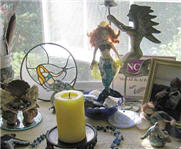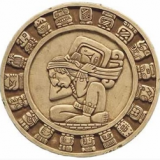Creating Your Own Sacred Space with Homemade Altars
By Toria Betson
I have altars all over my house, from tiny windowsill altars, to the large healing altar on the fireplace mantle. Any surface that isn’t covered with books, has an altar built on it. I feel that spirituality can play a major role in healing, and a home altar is one way to help make spirituality a part of your everyday life.
An altar is a sacred space, which may serve as a place to focus your intent and gratitude, or as a focal point for meditation, prayer, or spell-work, or as a place to help you connect with spirit.
There are no hard fast rules for building an altar. It may be simple or complex, indoors or out; it may serve a multitude of purposes, or be focused on just one, like healing. A simple Zen style altar, with one or few items on it, might be right for you. Nature child that I am, mine tend toward the cluttered, and are filled with found objects.
When you decide to build a healing altar, think about your intended purpose for the altar. Will it be a place for prayer, or to send healing energy to another?…to many others …to yourself?
Maybe you want a simple reminder to think positive healing thoughts. If so, a small altar placed where you will see it often will suffice. A tiny shelf near the kitchen sink could do. A fountain on your desk, with a small statue of Quan Yin, may remind you to be compassionate with yourself.
An altar designed to send healing to many others will probably be larger. It could display pictures of people you are praying for. Those who practice earth-based energy healing may choose to keep their tools on their altar, such as crystals, a rattle, and smudge sticks.
To begin creating your homemade altar, separate the sacred area from the surrounding areas. This could be a table, which works as the altar itself. You could use a shelf, hanging on a wall. You might build a small raised altar area on a larger surface, such as a dresser top, or you might simply separate an area with a cloth or scarf.
Using a cloth or scarf not only brings the objects together, but its color and design may symbolize healing as well. Generally speaking, for a healing altar, bright, clean colors work best. White is always an excellent choice. Blue, lavender, and other pastels also raise energy vibrations. You may wish to research colors to find one that works best for your ailment.
 Next, you will want to choose an item to be the central focus. It may be an item that helps you feel connected with spirit, such as a statue of an angel. If you choose a photograph of the person that needs healing, make sure it shows them happy and in good health. If you are using your altar for meditation, you might consider hanging a mandala over your altar. A large crystal would serve as an excellent tool for focusing energy. Any items on a healing altar should be unbroken, and in good condition.
Next, you will want to choose an item to be the central focus. It may be an item that helps you feel connected with spirit, such as a statue of an angel. If you choose a photograph of the person that needs healing, make sure it shows them happy and in good health. If you are using your altar for meditation, you might consider hanging a mandala over your altar. A large crystal would serve as an excellent tool for focusing energy. Any items on a healing altar should be unbroken, and in good condition.
I prefer my altars to have at least one item representing each of the four elements: Fire, Water, Earth, and Air. A candle or wand could symbolize Fire. Water is perhaps the most healing of all the elements, especially for emotional healing. It might be represented with a water fountain, or seashells, maybe a flowing blue scarf, or a bowl or chalice. Crystals, rocks collected on the beach, plants, flowers, or a pentagram, could stand for Earth. Plants symbolize life and vitality, so it’s important to replace them before they become tired or wilted. Air could be symbolized by a feather, incense, or bell.
Be creative, it’s your altar! Use what has meaning to you. Is there something that might symbolize the kind of healing you need?
Gratitude is an important key to manifestation. One way to show gratitude is with a prayer, or gratitude, bowl. Write down all the healthy things you are grateful for, even those you have yet to receive, and place them in a pot or bowl. Healing begins the moment you ask, so it’s never too early to say thank you. There is a long tradition of altars holding offerings. I like to leave offerings that are symbolic of the health issue, and I often use selected herbs or flowers. With intent, lighting a candle or incense can be used as an offering of gratitude.
Above all else, your healing altar should be a place of tranquility and peace–an everyday reminder that you are part of something much bigger.






